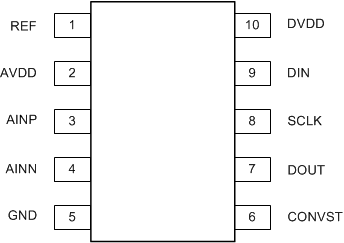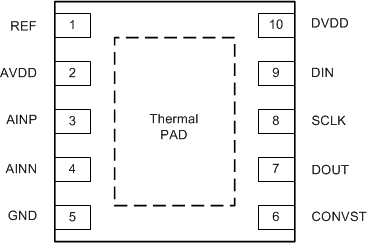SBAS547D May 2013 – August 2015 ADS8881
PRODUCTION DATA.
- 1 Features
- 2 Applications
- 3 Description
- 4 Revision History
- 5 Companion Products
- 6 Device Comparison
- 7 Pin Configurations and Functions
- 8 Specifications
- 9 Parametric Measurement Information
- 10Detailed Description
-
11Application and Implementation
- 11.1 Application Information
- 11.2 Typical Applications
- 12Power-Supply Recommendations
- 13Layout
- 14Device and Documentation Support
- 15Mechanical, Packaging, and Orderable Information
パッケージ・オプション
メカニカル・データ(パッケージ|ピン)
サーマルパッド・メカニカル・データ
- DRC|10
発注情報
7 Pin Configurations and Functions
DGS Package
VSSOP-10
Top View, Not to Scale

DRC Package
VSON-10
Top View, Not to Scale

Pin Functions
| PIN | I/O | DESCRIPTION | |
|---|---|---|---|
| NAME | NO. | ||
| AINN | 4 | Analog input | Inverting analog signal input |
| AINP | 3 | Analog input | Noninverting analog signal input |
| AVDD | 2 | Analog | Analog power supply. This pin must be decoupled to GND with a 1-μF capacitor. |
| CONVST | 6 | Digital input | Convert input. This pin also functions as the CS input in 3-wire interface mode; see the Description and Timing Requirements sections for more details. |
| DIN | 9 | Digital input | Serial data input. The DIN level at the start of a conversion selects the mode of operation (such as CS or daisy-chain mode). This pin also serves as the CS input in 4-wire interface mode; see the Description and Timing Requirements sections for more details. |
| DOUT | 7 | Digital output | Serial data output |
| DVDD | 10 | Power supply | Digital interface power supply. This pin must be decoupled to GND with a 1-μF capacitor. |
| GND | 5 | Analog, digital | Device ground. Note that this pin is a common ground pin for both the analog power supply (AVDD) and digital I/O supply (DVDD). The reference return line is also internally connected to this pin. |
| REF | 1 | Analog | Positive reference input. This pin must be decoupled with a 10-μF or larger capacitor. |
| SCLK | 8 | Digital input | Clock input for serial interface. Data output (on DOUT) are synchronized with this clock. |
| Thermal pad | — | Thermal pad | Exposed thermal pad (only for the DRC package option). Texas Instruments recommends connecting the thermal pad to the printed circuit board (PCB) ground. |